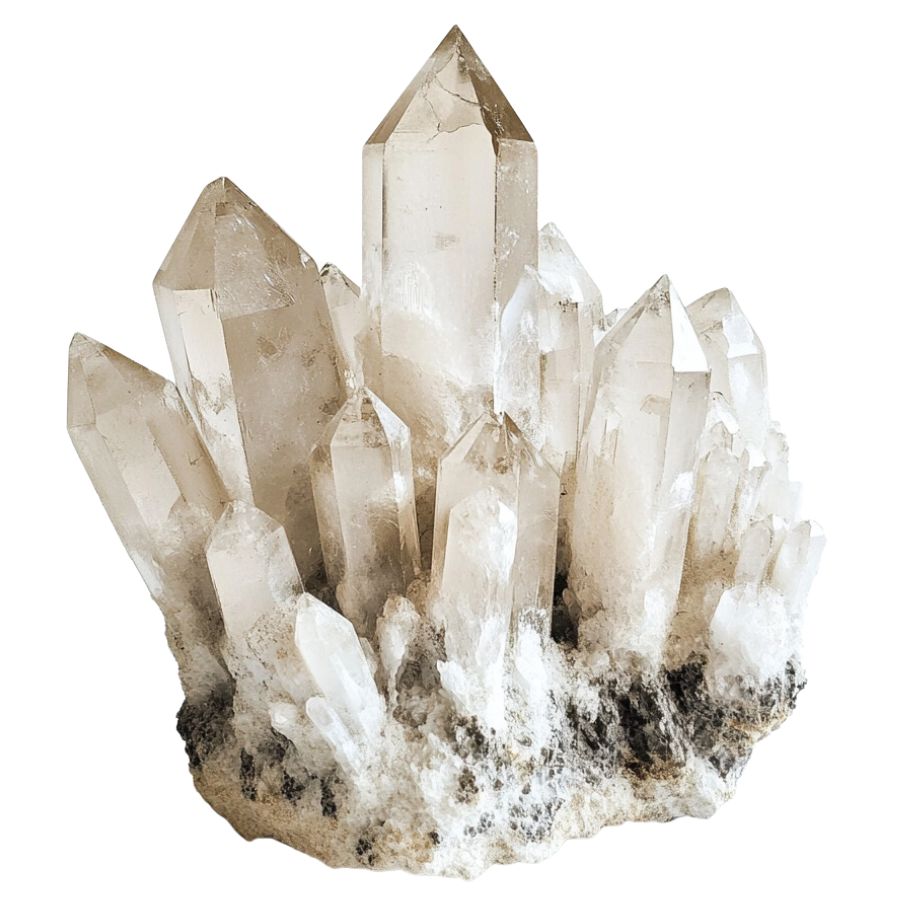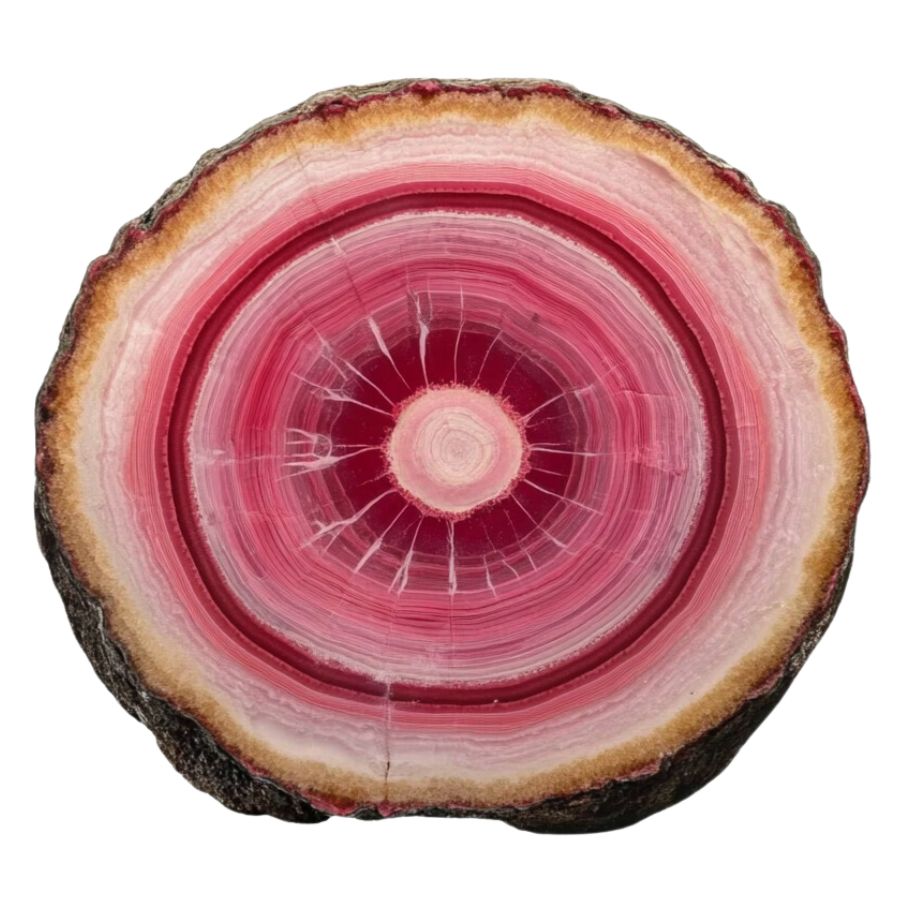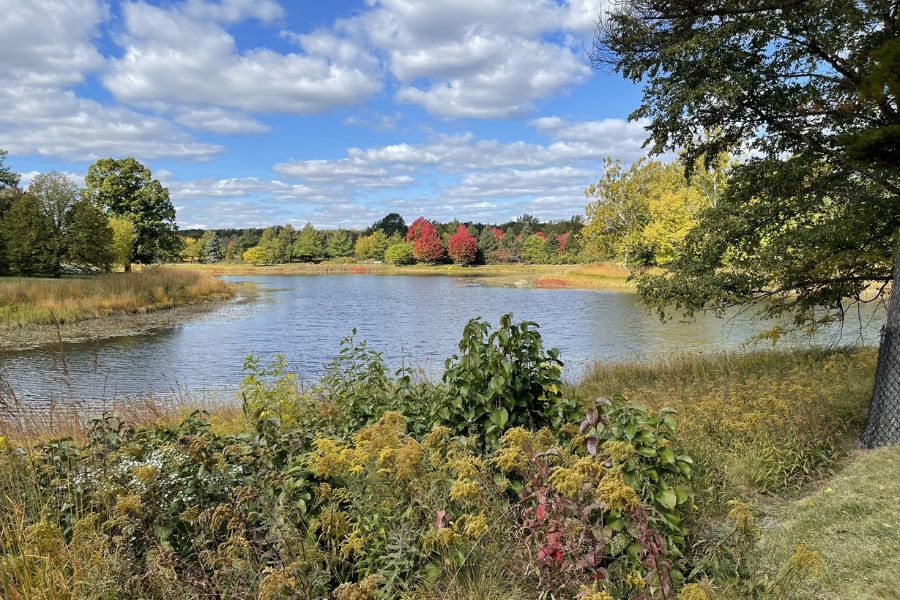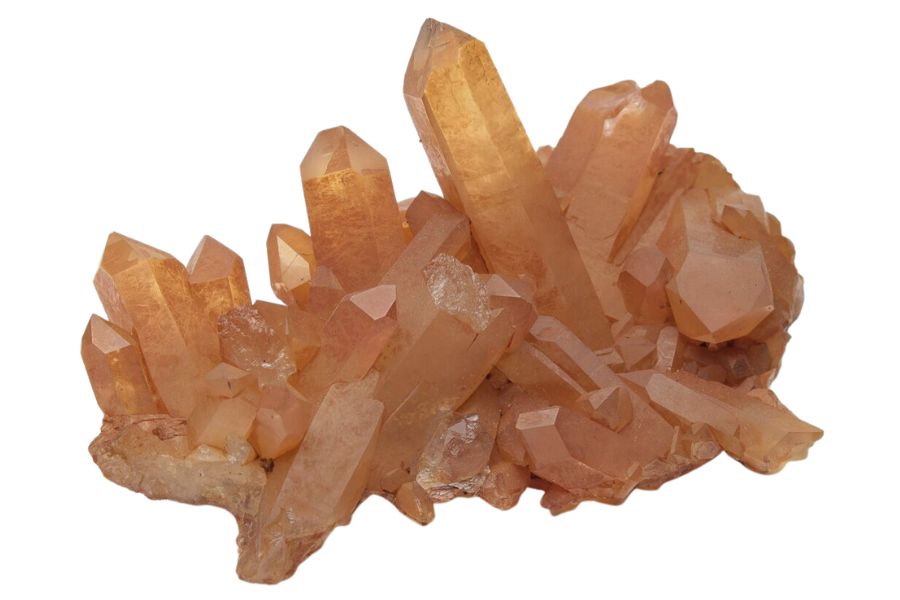Finding crystals can be a rewarding adventure, offering a unique way to explore the natural beauty and geology of the region. Whether you’re a seasoned rockhound or just getting started, knowing where to look is key to uncovering these hidden treasures.
In this state, a variety of locations provide opportunities to discover different types of crystals. From rocky outcrops in the mountains to stream beds that carry sparkling surprises, each area offers its own unique finds for those willing to search.
We can help you get started with some places you can explore for crystals below!
Crystals you can find in the US
The United States offers a wide range of crystals that reflect its diverse geology. From vibrant gems to more subtle mineral formations, there’s something to discover in nearly every region.
Calcite

With a variety of forms and a unique property of double refraction, calcite allows objects viewed through the crystal to appear doubled. This mineral can appear in a spectrum of colors, with pure forms typically being transparent or white.
In addition, calcite reacts vigorously with acids, which aids in distinguishing it from other minerals. It also frequently contributes to the structure of sedimentary rocks such as limestone.
Gypsum

Gypsum’s notable softness allows it to be easily scratched with just a fingernail, often presenting as white or very light-colored in its pure form.
It manifests in both crystalline forms, like selenite, and massive forms such as alabaster, making it versatile in use and appearance.
Gypsum is also essential in the construction industry and is a key component in the manufacture of plaster and drywall.
Fluorite

Fluorite comes in a wide range of vibrant colors, including purples, greens, blues, and yellows, and is known for forming in well-defined cubic crystals.
Beyond this, fluorite exhibits fluorescence under ultraviolet light! It can also be used in various industrial applications, including as a flux in steelmaking.
Galena

Galena distinguishes itself with a metallic luster and high density, typically found in a cube-like form. It serves as the primary ore of lead, making it important in the metal industry, while its shiny, silver color attracts collectors.
Not only does its appearance make it a subject of interest, but its weight and texture provide tangible lessons in mineral density and metallic properties. Galena also often contains traces of silver, adding to its commercial and educational value.
Corundum

Corundum is a mineral that comes in a variety of colors, though it is typically transparent or gray. Its most famous forms are sapphires and rubies, which are prized for their vibrant blue and red hues.
The mineral is known for its remarkable hardness, ranking just below diamond on the Mohs scale. This durability makes corundum ideal for industrial abrasives and cutting tools, as well as a popular choice for fine jewelry.
Quartz

Quartz is among the most common minerals in the Earth’s crust and is prized for its durability and variety. It forms in a wide range of colors and types, from clear rock crystal to purple amethyst.
The mineral is notable for its hardness and durability, which contribute to its use in a variety of applications. Quartz is also popular in the manufacturing of electronics and watches due to its piezoelectric properties, which allow it to convert mechanical pressure into electrical energy.
Pyrite

Often mistaken for gold due to its metallic luster and pale brass-yellow hue, pyrite is known colloquially as “fool’s gold.” Its characteristic cube-shaped crystal formations look man-made but are actually completely naturally formed!
Pyrite also has historical importance in producing sulfur dioxide for sulfuric acid production.
Rhodochrosite

Rhodochrosite stands out with its rich pink and red hues, making it highly desirable as both a mineral specimen and a gemstone.
It typically forms in layered or stalactitic structures, with bands of colors that showcase how it grew over millions of years.
Beyond its beauty, rhodochrosite is significant as the main source of manganese, an essential element used in metal alloys.
Rhodonite

Appreciated for its deep pinks and reds, often complemented by black manganese oxide veins, rhodonite presents a dramatic appearance. It is typically found in metamorphic rocks and is used both as an ornamental stone and in jewelry.
In geology, rhodonite is significant for its role in metamorphic processes and its association with other manganese-rich minerals. It can be found in metamorphosed sedimentary rocks and is sometimes used as an indicator of the presence of manganese deposits.
Vivianite

Vivianite, an iron phosphate mineral, emerges in low-oxygen environments like peat bogs or iron-rich deposits. Its striking blue to green color, which can change to a lighter shade over time due to oxidation, makes it a distinctive mineral.
Found in various geological settings, vivianite provides clues about the local conditions and the presence of phosphate deposits.
The Types of Crystals We Found

If you want to hunt for crystals in Kentucky, here are the crystals you can expect to find:
Rare crystals found in Kentucky
- Apatite
- Garnet
- Jasper
- Serpentine
More common crystals found here
- Agate
- Calcite
- Chalcedony
- Fluorite
- Galena
- Hematite
- Pyrite
- Quartz
What rough crystals look like
When you’re out looking for crystals on your own it’s important to know what you’re looking for. This is what you need to look out for:
Look for exteriors like this

When you’re out searching for crystals in the wild, it’s essential to keep in mind that what you find won’t look like the polished stones you see in stores. One important tip is to consider what certain crystals look like in their raw, natural form.
Without the shine and smooth finish, crystals might appear rough, with jagged edges or earthy tones masking their true beauty. Understanding this can help you spot potential finds that might otherwise be overlooked.
Examine the crystal structure and shape

Crystals often form in specific geometric patterns that can be key to identifying them. For example, quartz is known for its hexagonal prisms, while halite typically forms cubic shapes.
By recognizing these distinct patterns, you can differentiate between various types of crystals and better understand what you’ve found.
Observe color

Some crystals are known for their distinct hues, like the deep purple of amethyst or the vibrant green of emerald. However, not all crystals will have strong colors; some may be clear or only slightly tinted.
Check the luster

Luster refers to how a crystal’s surface interacts with light. Some crystals might have a shiny, glassy luster, while others may appear metallic or dull. This characteristic can help you determine the type of crystal you’ve found.
However, it’s important to remember that luster isn’t always obvious right away. In some cases, a crystal’s true luster will only become apparent after it’s been cleaned or polished, so keep this in mind as you examine your finds.
Evaluate the transparency

Pay close attention to how much light passes through the crystal. Some crystals are completely clear, allowing light to pass through easily, while others may be opaque and block light entirely.
You might also encounter crystals with translucent edges but opaque centers. These variations in transparency can offer valuable clues about the type of crystal you’ve found, making it easier to identify and appreciate your discovery.
A Quick Request About Collecting
Always Confirm Access and Collection Rules!
Before heading out to any of the locations on our list you need to confirm access requirements and collection rules for both public and private locations directly with the location. We haven’t personally verified every location and the access requirements and collection rules often change without notice.
Many of the locations we mention will not allow collecting but are still great places for those who love to find beautiful rocks and minerals in the wild without keeping them. We also can’t guarantee you will find anything in these locations since they are constantly changing.
Always get updated information directly from the source ahead of time to ensure responsible rockhounding. If you want even more current options it’s always a good idea to contact local rock and mineral clubs and groups
Tips on where to look
Having a better idea of where to look can greatly narrow down your search and increase your chances of finding crystals. By focusing on environments where crystals are likely to be exposed, you can spend less time searching and more time discovering.
Outcrops and Exposed Rock

Rocky outcrops are prime locations for finding crystals and minerals. Search along the edges of outcrops, particularly where erosion has worn away the surrounding soil, revealing the rock underneath.
Pay close attention to any visible cracks, crevices, or small cavities within the outcrop, as these are often where crystals develop and can be extracted with minimal effort.
Stream Beds and Gravel Deposits

Stream beds are dynamic environments where water flow constantly shapes the landscape. Over time, water can erode rocks upstream, breaking them down and carrying mineral fragments, including crystals, downstream.
When searching in these areas, look for spots where the current has slowed, such as bends in the stream or areas behind large rocks, as these are prime locations for deposits.
Quarries and Mines

Quarries and mines are excellent places to search for crystals because they expose deep layers of rock that would otherwise be hidden beneath the surface. These sites often contain a variety of minerals and crystals that have been brought to the surface during excavation.
Pay attention to tailings piles, where waste rock is discarded, as they often contain overlooked or broken crystals. Always prioritize safety when exploring these areas and ensure that you have permission to search.
Road Cuts and Construction Sites

As roads are cut through hillsides or construction projects dig deep foundations, layers of rock and soil that have been undisturbed for millions of years are suddenly exposed.
Look for freshly exposed rock faces, especially where blasting has occurred, as this can create fissures or expose pockets filled with crystals. Be cautious around active construction sites, and always seek permission before exploring.
Mountainous Areas

In mountainous regions, erosion caused by wind, rain, and ice can wear away the softer rock, exposing harder crystals that have formed within. Focus on weathered and broken rock formations.
Look for scree slopes, where loose rock has accumulated at the base of cliffs. Additionally, areas near fault lines or volcanic vents are particularly promising, as they often have a higher concentration of minerals.

The tools every crystal hunter will need
When you're out looking for crystals having the right tools for the job is very important. You don't need a lot for most trips but there are a handful that are critical and will make your life a lot easier.
We get asked a lot about the equipment we use. Over the years we've found a handful of tools that we recommend to both new and experienced crystal miners which we outline in great detail in our complete rockhounding equipment guide. These are quality options that also happen to be relatively inexpensive.
Below are the basic tools that make your life so much easier and save you a ton of time. Check out the full guide to see everything we recommend bringing. One quick note, as an Amazon Associate I earn from qualifying purchases but we try very hard to only recommend gear we would use ourselves and often recommend brands you can't find on Amazon.
At a minimum you should have:
1 - Sturdy rock hammer: The Estwing Rock Pick is our standard
2 - Rugged chisels: Try Kendo' 3-piece Chisel Set
3 - Compact shovel: The Koleiya 28-inch shovel works well
4 - Rock screen pan: The Wazakura Soil Sieve Set fits the bill
5 - Eye protection: DeWalt Safety Glasses are cheap and comfortable
6 - Head protection: Malta's Safety Helmet has been our go-to
7 - Jewelers lens with at least 20x magnification: Jarlink's Jewelers Loop is perfect
The crystal-finding books that we use most
There are also a few books that have been extremely helpful in the search for gems. These books have great recommendations and tips:
National Audubon Society Field Guide to Rocks and Minerals: North America
Southeast Treasure Hunter's Gem & Mineral Guide
Earth Treasures: The Southeastern Quadrant
We provide links to find these tools on Amazon but some can also be found at your local hardware stores. For more recommendations check out the link to our full tool guide above.
The Mining Laws And Regulations You Should Know
Hunting for crystals on public lands is often allowed, but specific rules and regulations are put into place by the Kentucky Department of Parks. Some public lands may require permits for certain activities or restrict collecting.
Remember that regulations may vary depending on the location, and it is vital to research the specific rules governing the area you plan to visit.
Consulting local authorities and land managers or visiting official websites can provide the most accurate and up-to-date information regarding recreational crystal hunting regulations in Kentucky.
- The extensive local experience and understanding of our team
- Input from multiple local crystal hunters and crystal collecting groups
- The accessibility of the crystal mining locations
- Safety and potential hazards when collecting
- Private and public locations
- A desire to include locations for both experienced crystal hunters and those who are just starting out
Using these weights we think we’ve put together the best list out there for those who love finding new crystals for our collections!
The Best Locations For Crystal Mining in Kentucky

Here are our best picks for locations to hunt for crystals in Kentucky. We’ve had a lot of success exploring them and discovering unique crystals!
Always Confirm Access and Collection Rules!
Before heading out to any of the locations on our list you need to confirm access requirements and collection rules for both public and private locations directly with the location. We haven’t personally verified every location and the access requirements and collection rules often change without notice.
Many of the locations we mention will not allow collecting but are still great places for those who love to find beautiful rocks and minerals in the wild without keeping them. We also can’t guarantee you will find anything in these locations since they are constantly changing.
Always get updated information directly from the source ahead of time to ensure responsible rockhounding. If you want even more current options it’s always a good idea to contact local rock and mineral clubs and groups
Ellis Mine

Located in the Western Kentucky Fluorspar District, Ellis Mine is a good place to explore if you want to find gems in Kentucky.
This old mine was a bustling spot for mining fluorspar, a valuable mineral in the steel and aluminum industries.
The terrain here is quite varied, with areas of dense vegetation and rocky outcrops. It’s a bit rugged, so when you visit, make sure you’re prepared for some hiking and climbing.
Where we found crystals at Ellis Mine
We have collected various crystals in the Ellis Mine area, including calcite, fluorite, and quartz.

The tools every crystal hunter will need
When you're out looking for crystals having the right tools for the job is very important. You don't need a lot for most trips but there are a handful that are critical and will make your life a lot easier.
We get asked a lot about the equipment we use. Over the years we've found a handful of tools that we recommend to both new and experienced crystal miners which we outline in great detail in our complete rockhounding equipment guide. These are quality options that also happen to be relatively inexpensive.
Below are the basic tools that make your life so much easier and save you a ton of time. Check out the full guide to see everything we recommend bringing. One quick note, as an Amazon Associate I earn from qualifying purchases but we try very hard to only recommend gear we would use ourselves and often recommend brands you can't find on Amazon.
At a minimum you should have:
1 - Sturdy rock hammer: The Estwing Rock Pick is our standard
2 - Rugged chisels: Try Kendo' 3-piece Chisel Set
3 - Compact shovel: The Koleiya 28-inch shovel works well
4 - Rock screen pan: The Wazakura Soil Sieve Set fits the bill
5 - Eye protection: DeWalt Safety Glasses are cheap and comfortable
6 - Head protection: Malta's Safety Helmet has been our go-to
7 - Jewelers lens with at least 20x magnification: Jarlink's Jewelers Loop is perfect
The crystal-finding books that we use most
There are also a few books that have been extremely helpful in the search for gems. These books have great recommendations and tips:
National Audubon Society Field Guide to Rocks and Minerals: North America
Southeast Treasure Hunter's Gem & Mineral Guide
Earth Treasures: The Southeastern Quadrant
We provide links to find these tools on Amazon but some can also be found at your local hardware stores. For more recommendations check out the link to our full tool guide above.
Gratz Mine

Gratz Mine, located in Owen County, Kentucky, is a historic site. This mine was once a bustling hub where miners diligently extracted lead, zinc, and silver.
Although mining operations have ceased, the area is now a popular destination if you want to look for crystals.
For crystal enthusiasts, Gratz Mine is an ideal spot to explore. Its mineral-rich deposits contain a variety of stunning specimens, such as galena and beautiful calcite crystals.
Where we found crystals at Gratz Mine
Calcite, fluorite, and galena crystals can be discovered at Gratz Mine. You can find out how much are crystals worth through this detailed guide.
Morton Branch

Morton Branch is known for its abundance of quartz crystals, which exhibit a dazzling array of colors and formations. Exploring this location, you’ll have the opportunity to find stunning specimens that will be a true testament to nature’s beauty and wonder.
Visiting Morton Branch offers a chance to immerse yourself in Kentucky’s natural landscape while searching for geological treasures.
To make the most of your adventure, come prepared with the right tools and equipment, and be ready to explore this fascinating location.
Where we found crystals at Morton Branch
Fluorite crystals are primarily found at Morton Branch.
Ohio River

The Ohio River, a significant waterway in Kentucky, spans approximately 981 miles and has long been a vital transportation route and source of livelihood for the region.
Beyond its historical importance, the Ohio River offers a unique opportunity for those interested in crystals. The riverbanks and surrounding areas are rich in mineral deposits, making them a treasure trove for rockhounds eager to uncover hidden gems.
The constant erosion and movement of the water have exposed various rocks and minerals, making them easier to spot.
To make the most of your adventure, come prepared with the necessary tools, equipment, and a willingness to search the riverbanks and surrounding areas.
Where we found crystals at the Ohio River
The area along the Ohio River is abundant in calcite, fluorite, galena, and pyrite crystals.
Pygmy Fluorspar Mine

In the early 20th century, Pygmy Fluorspar Mine contributed to the region’s economic development, with miners extracting the valuable mineral for several decades.
Though mining operations eventually ceased, it’s still a good spot to explore if you want to collect some samples of fascinating rocks.
The area is known for its abundant deposits of fluorite, which can be found in striking colors and formations. Other minerals such as calcite, barite, and quartz can be discovered, making this location a haven for crystal hunters.
Where we found crystals at Pygmy Fluorspar Mine
At the Pygmy Fluorspar Mine, we had the most success finding several crystal types, including fluorite, galena, and pyrite crystals.
Our Other Favorite Places For Crystal Hunting

There are many more amazing places to look for crystals and dig for geodes in Kentucky. We’ve included a list of additional options worth thinking about:
Where you can find crystals for free
We’ll go over a few places where you can search for crystals without paying. Even though many great attractions have entrance fees, other areas are still free to visit.
| County | Location |
| Caldwell | In fault exposures at Crider for fluorite |
| Caldwell | In area quarries of Princeton for calcite and fluorite |
| Crittenden | Crittenden Springs fault for calcite, fluorite, galena, and pyrite |
| Elliott | Igneous outcrops in the Little Sandy River area for apatite and quartz |
| Elliott | In the peridotite outcrops along the banks of Ison Creek of Isonville for garnet and serpentine |
| Garrard | Boone Creek in barite prospects for clcite and fluorite |
| Graves | Regional gravel and clay pits at Farmington, Hickory, Sedalia, and Viola for agate, chalcedony, jasper, and quartz |
| Graves | Area clay pits of Mayfield for agate, chalcedony, jasper, and quartz. |
| Livingston | Two abandoned quarries in Birdsville for calcite, fluorite, and quartz. |
| Lyon | Excavations, area gravel puts, and road cuts in Eddyville for agate, chalcedony, and quartz. |
Other great places to dig for crystals
You can hunt for crystals at other locations if you want to spend money. The price will vary seasonally, and occasionally, it can be free. You have to get in touch with them before going to these locations.
| County | Location |
| Bath | Area iron mines at Owingsville for hematite |
| Bourbon | Area mines at Millersburg for galena |
| Caldwell | Many mines throughout the west part of the county for calcite and fluorite |
| Caldwell – Crittenden | Many well-known old mines such as Ashbridge, Glendale, Tabor, and other regional mines back of the Ohio River for galena and fluorite |
| Livingston | Area fluorspar mines at Carrsville for calcite, fluorite, galena, and quartz |
| Livingston | Area fluorspar mines at Joy for calcite, fluorite, galena, and quartz |
| Livingston | Dyer Hill fluorspar mine for calcite, fluorite, galena, and quartz |
| Mercer | Area mines at Harrodsburg for calcite, fluorite, and galena |
The Best Crystal Shops In The Area

If you’re not really fond of exploring and getting your hands dirty, but you still want to have interesting crystal specimens, these shops are worth visiting.
These are the best crystal stores we could find if you’re looking for unique and stunning specimens.
- Creatures of Whim – 126 N Broadway, Lexington, KY 40507
- The Crystal Coven – 1129 W Lexington Ave, Winchester, KY 40391
- Goldheart: Stones and Such – 980 Barret Ave, Louisville, KY 40204
- House of Onyx – 120 Main St, Greenville, KY 42345
- Moon Struck – 3207 College Dr, Jeffersontown, KY 40299
- Nice Rock Shop – 311 Broadway St, Paducah, KY 42001
- Onyx Cave Rock Shop – 93 Huckleberry Knob Rd, Cave City, KY 42127
- Serendipity Corner – 420 E Main St F, Mt Sterling, KY 40353
- Stix-N-Stonz – 2234 Dundee Rd, Louisville, KY 40205
- White Willow Emporium – 400 Old Vine St #100, Lexington, KY 40507
Additional places to find crystals in nearby states
If you’ve already tried all of our recommendations above or are planning a trip out of the state, you should check out our guides for neighboring states:
- Crystals in Illinois
- Crystals in Indiana
- Crystals in Missouri
- Crystals in Ohio
- Crystals in Tennessee
- Crystals in Virginia
- Crystals in West Virginia
If you have any recommendations we haven’t covered please leave them in the comments below!

